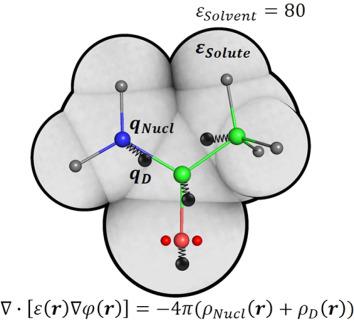当前位置:
X-MOL 学术
›
J. Comput. Chem.
›
论文详情
Our official English website, www.x-mol.net, welcomes your
feedback! (Note: you will need to create a separate account there.)
Combining the polarizable Drude force field with a continuum electrostatic Poisson-Boltzmann implicit solvation model
Journal of Computational Chemistry ( IF 3.4 ) Pub Date : 2018-05-08 , DOI: 10.1002/jcc.25345 Alexey Aleksandrov 1 , Fang-Yu Lin 2 , Benoît Roux 3 , Alexander D. MacKerell 2
Journal of Computational Chemistry ( IF 3.4 ) Pub Date : 2018-05-08 , DOI: 10.1002/jcc.25345 Alexey Aleksandrov 1 , Fang-Yu Lin 2 , Benoît Roux 3 , Alexander D. MacKerell 2
Affiliation

|
In this work, we have combined the polarizable force field based on the classical Drude oscillator with a continuum Poisson–Boltzmann/solvent‐accessible surface area (PB/SASA) model. In practice, the positions of the Drude particles experiencing the solvent reaction field arising from the fixed charges and induced polarization of the solute must be optimized in a self‐consistent manner. Here, we parameterized the model to reproduce experimental solvation free energies of a set of small molecules. The model reproduces well‐experimental solvation free energies of 70 molecules, yielding a root mean square difference of 0.8 kcal/mol versus 2.5 kcal/mol for the CHARMM36 additive force field. The polarization work associated with the solute transfer from the gas‐phase to the polar solvent, a term neglected in the framework of additive force fields, was found to make a large contribution to the total solvation free energy, comparable to the polar solute–solvent solvation contribution. The Drude PB/SASA also reproduces well the electronic polarization from the explicit solvent simulations of a small protein, BPTI. Model validation was based on comparisons with the experimental relative binding free energies of 371 single alanine mutations. With the Drude PB/SASA model the root mean square deviation between the predicted and experimental relative binding free energies is 3.35 kcal/mol, lower than 5.11 kcal/mol computed with the CHARMM36 additive force field. Overall, the results indicate that the main limitation of the Drude PB/SASA model is the inability of the SASA term to accurately capture non‐polar solvation effects. © 2018 Wiley Periodicals, Inc.
中文翻译:

将极化德鲁德力场与连续静电泊松-玻尔兹曼隐式溶剂化模型相结合
在这项工作中,我们将基于经典德鲁德振荡器的极化力场与连续泊松-玻尔兹曼/溶剂可及表面积 (PB/SASA) 模型相结合。在实践中,经历由固定电荷和溶质的诱导极化引起的溶剂反应场的德鲁德粒子的位置必须以自洽的方式进行优化。在这里,我们参数化模型以重现一组小分子的实验溶剂化自由能。该模型再现了 70 个分子的良好实验溶剂化自由能,对于 CHARMM36 加性力场,均方根差为 0.8 kcal/mol,而均方根差为 2.5 kcal/mol。与溶质从气相转移到极性溶剂相关的极化功,这是在加性力场框架中被忽略的一个术语,发现对总溶剂化自由能有很大贡献,与极性溶质 - 溶剂溶剂化贡献相当。Drude PB/SASA 还很好地再现了来自小蛋白质 BPTI 的显式溶剂模拟的电子极化。模型验证基于与 371 个单丙氨酸突变的实验相对结合自由能的比较。使用 Drude PB/SASA 模型,预测的和实验的相对结合自由能之间的均方根偏差为 3.35 kcal/mol,低于使用 CHARMM36 附加力场计算的 5.11 kcal/mol。总体而言,结果表明 Drude PB/SASA 模型的主要限制是 SASA 项无法准确捕捉非极性溶剂化效应。© 2018 Wiley Periodicals, Inc.
更新日期:2018-05-08
中文翻译:

将极化德鲁德力场与连续静电泊松-玻尔兹曼隐式溶剂化模型相结合
在这项工作中,我们将基于经典德鲁德振荡器的极化力场与连续泊松-玻尔兹曼/溶剂可及表面积 (PB/SASA) 模型相结合。在实践中,经历由固定电荷和溶质的诱导极化引起的溶剂反应场的德鲁德粒子的位置必须以自洽的方式进行优化。在这里,我们参数化模型以重现一组小分子的实验溶剂化自由能。该模型再现了 70 个分子的良好实验溶剂化自由能,对于 CHARMM36 加性力场,均方根差为 0.8 kcal/mol,而均方根差为 2.5 kcal/mol。与溶质从气相转移到极性溶剂相关的极化功,这是在加性力场框架中被忽略的一个术语,发现对总溶剂化自由能有很大贡献,与极性溶质 - 溶剂溶剂化贡献相当。Drude PB/SASA 还很好地再现了来自小蛋白质 BPTI 的显式溶剂模拟的电子极化。模型验证基于与 371 个单丙氨酸突变的实验相对结合自由能的比较。使用 Drude PB/SASA 模型,预测的和实验的相对结合自由能之间的均方根偏差为 3.35 kcal/mol,低于使用 CHARMM36 附加力场计算的 5.11 kcal/mol。总体而言,结果表明 Drude PB/SASA 模型的主要限制是 SASA 项无法准确捕捉非极性溶剂化效应。© 2018 Wiley Periodicals, Inc.











































 京公网安备 11010802027423号
京公网安备 11010802027423号